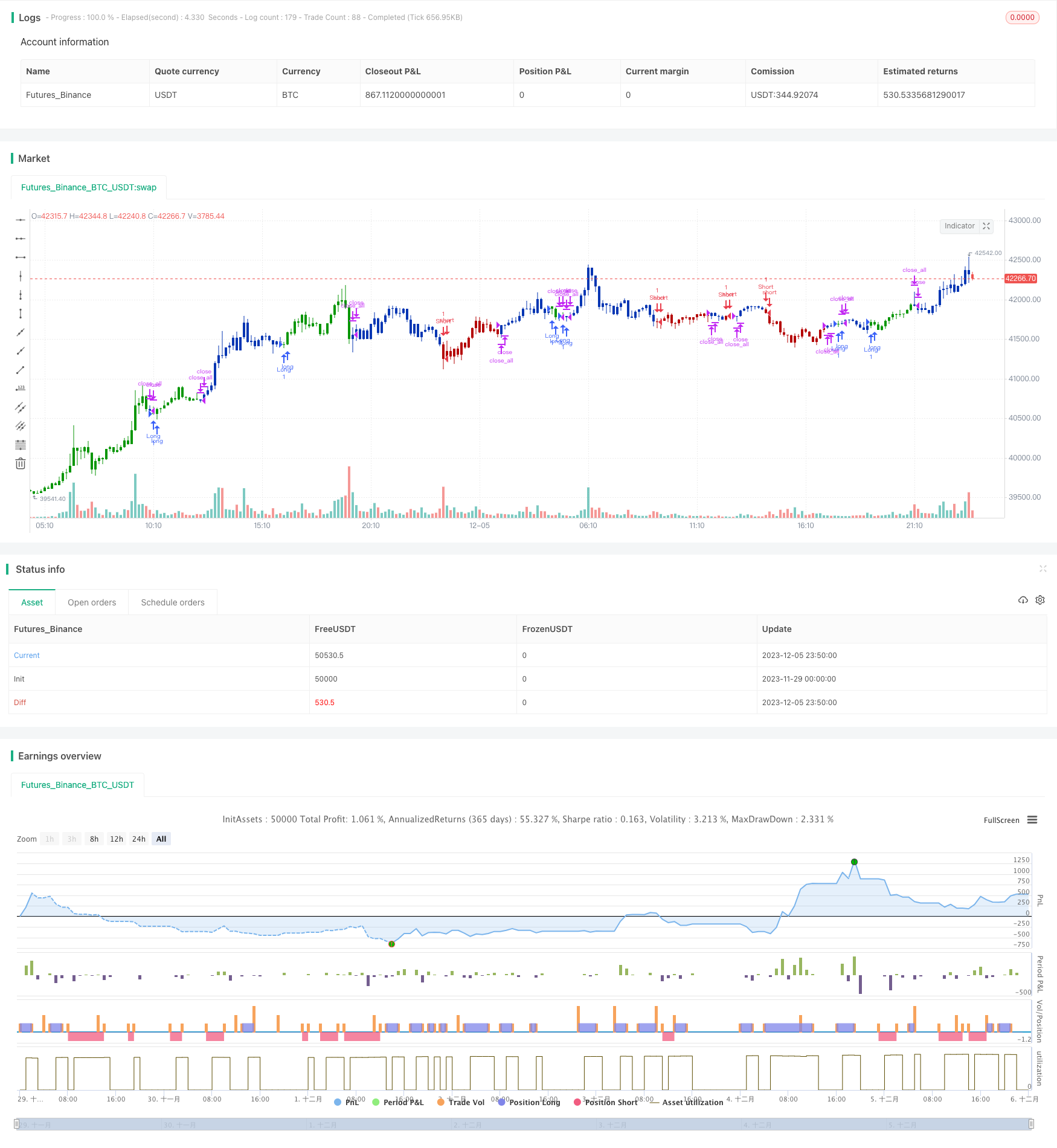
概述
本策略结合了123反转和质数震荡指标两个因子,实现双因子驱动的量化交易。该策略捕捉短期反转机会的同时,也能识别更长期的趋势,实现低风险 excess return。
策略原理
第一部分为123反转策略。该策略利用2日内收盘价反转的特征来判断买卖点。当收盘价连续2日上涨且慢速K线低于50时,认为矫枉过正,产生买点;当收盘价连续2日下跌且快速K线高于50时,认为反弹过头,产生卖点。
第二部分为质数震荡指标策略。该指标计算指定价格区间内最接近当前价格的质数,并输出与当前价格的差值。正值表示当前价格接近质数上限,负值表示当前价格接近质数下限。根据差值判断趋势,与123反转信号进行结合,产生最终交易信号。
两个子策略的交易信号合并原则是:同向信号的情况下产生实际交易信号,异向信号的情况下暂不开仓。
优势分析
该策略结合双重因子,既考虑了短期反转效应,也兼顾了长期趋势特徵,多角度判断市场,提高策略抗风险能力。
相比单一 momentum 策略,本策略在突发事件造成价格短期跳水时,可以利用反转因子及时止损或反向开仓,有效控制 intraday risk。
相比单一反转策略,本策略引入质数震荡指标判断趋势方向,可以避免频繁反转交易造成 overtrading。
风险分析
该策略最大的风险在于两个因子之间存在信号冲突的情况。当 123 反转显示超买超卖迹象,产生反转信号,而质数震荡指标显示仍在趋势中时,如果直接反转交易可能导致亏损。
为控制此风险,策略加入了额外判断逻辑,只有当两因子信号同向时才产生实际交易信号。但这也可能错过部分交易机会。
优化方向
优化 Stochastic 指标参数,找到更适合具体标的的反转参数组合
优化质数震荡指标的容差百分比参数,降低噪音交易
增加止损策略,防止单向行情亏损扩大
增加仓位管理模块,不同市场环境下调整仓位
加入机器学习模型判断两因子信号可信度,降低信号冲突概率
总结
本策略成功结合短期反转因子与长期趋势因子,实现低风险的量化交易。有效利用双重因子过滤噪声交易,并设定额外判断逻辑控制风险,是一款平稳收益的实战策略。后续将持续进行参数优化与功能扩展,使策略更适应真实市场的特征。
/*backtest
start: 2023-11-29 00:00:00
end: 2023-12-06 00:00:00
period: 15m
basePeriod: 5m
exchanges: [{"eid":"Futures_Binance","currency":"BTC_USDT"}]
*/
//@version=4
////////////////////////////////////////////////////////////
// Copyright by HPotter v1.0 28/04/2021
// This is combo strategies for get a cumulative signal.
//
// First strategy
// This System was created from the Book "How I Tripled My Money In The
// Futures Market" by Ulf Jensen, Page 183. This is reverse type of strategies.
// The strategy buys at market, if close price is higher than the previous close
// during 2 days and the meaning of 9-days Stochastic Slow Oscillator is lower than 50.
// The strategy sells at market, if close price is lower than the previous close price
// during 2 days and the meaning of 9-days Stochastic Fast Oscillator is higher than 50.
//
// Second strategy
// Determining market trends has become a science even though a high number or people
// still believe it’s a gambling game. Mathematicians, technicians, brokers and investors
// have worked together in developing quite several indicators to help them better understand
// and forecast market movements.
//
// Developed by Modulus Financial Engineering Inc., the prime number oscillator indicates the
// nearest prime number, be it at the top or the bottom of the series, and outlines the
// difference between that prime number and the respective series.
//
// WARNING:
// - For purpose educate only
// - This script to change bars colors.
////////////////////////////////////////////////////////////
Reversal123(Length, KSmoothing, DLength, Level) =>
vFast = sma(stoch(close, high, low, Length), KSmoothing)
vSlow = sma(vFast, DLength)
pos = 0.0
pos := iff(close[2] < close[1] and close > close[1] and vFast < vSlow and vFast > Level, 1,
iff(close[2] > close[1] and close < close[1] and vFast > vSlow and vFast < Level, -1, nz(pos[1], 0)))
pos
PrimeNumberOscillator(price, percent) =>
res = 0.0
res1 = 0.0
res2 = 0.0
for j = price to price + (price * percent / 100)
res1 := j
for i = 2 to sqrt(price)
res1 := iff(j % i == 0 , 0, j)
if res1 == 0
break
if res1 > 0
break
for j = price to price - (price * percent / 100)
res2 := j
for i = 2 to sqrt(price)
res2 := iff(j % i == 0 , 0, j)
if res2 == 0
break
if res2 > 0
break
res := iff(res1 - price < price - res2, res1 - price, res2 - price)
res := iff(res == 0, res[1], res)
res
PNO(percent) =>
pos = 0.0
xPNO = PrimeNumberOscillator(close, percent)
pos:= iff(xPNO > 0, 1,
iff(xPNO < 0, -1, nz(pos[1], 0)))
pos
strategy(title="Combo Backtest 123 Reversal & Prime Number Oscillator", shorttitle="Combo", overlay = true)
line1 = input(true, "---- 123 Reversal ----")
Length = input(14, minval=1)
KSmoothing = input(1, minval=1)
DLength = input(3, minval=1)
Level = input(50, minval=1)
//-------------------------
line2 = input(true, "---- Prime Number Oscillator ----")
percent = input(5, minval=0.01, step = 0.01, title="Tolerance Percentage")
reverse = input(false, title="Trade reverse")
posReversal123 = Reversal123(Length, KSmoothing, DLength, Level)
posPNO = PNO(percent)
pos = iff(posReversal123 == 1 and posPNO == 1 , 1,
iff(posReversal123 == -1 and posPNO == -1, -1, 0))
possig = iff(reverse and pos == 1, -1,
iff(reverse and pos == -1 , 1, pos))
if (possig == 1 )
strategy.entry("Long", strategy.long)
if (possig == -1 )
strategy.entry("Short", strategy.short)
if (possig == 0)
strategy.close_all()
barcolor(possig == -1 ? #b50404: possig == 1 ? #079605 : #0536b3 )